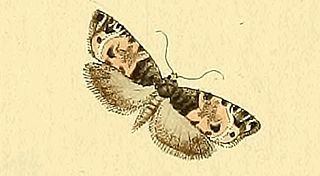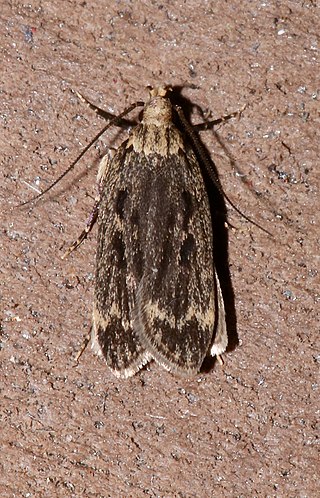
Lozotaenia forsterana is a moth of the family Tortricidae. It is found in Europe and across the Palearctic.

Aleimma loeflingiana is a moth of the family Tortricidae. It is found in Europe and the Near East.

Notocelia rosaecolana is a moth of the family Tortricidae. It is found in the Palearctic realm, where it has been recorded from China, Mongolia, Korea, Japan, Iran, Central Asia, Russia and Europe.

Epinotia tedella is a moth of the family Tortricidae. It is found in Europe.

Spaelotis ravida, the stout dart, is a moth of the family Noctuidae. The species was first described by Michael Denis and Ignaz Schiffermüller in 1775. It is found in the Palearctic realm.

Gypsonoma aceriana, the poplar shoot-borer, is a moth of the family Tortricidae. It is found from Europe to Russia, eastern Turkey and Iraq. It is also present in North Africa.

Rhopobota naevana, the holly tortrix moth, holly leaf tier or blackheaded fireworm, is a moth of the family Tortricidae. It is found from Europe to eastern Russia, China, Taiwan, Mongolia, Korea and Japan. It is also present in India, Sri Lanka and North America.

Epinotia nisella is a moth of the family Tortricidae which is found in the Palearctic, Europe and North America. It was first described by Carl Alexander Clerck in 1759.

Cochylis hybridella is a moth species of the family Tortricidae. It is found in most of Europe, the Near East, China, Japan, Korea and Russia.

Epinotia tetraquetrana, the square-barred bell, is a moth of the family Tortricidae. It is found from most of Europe east to the Near East and the eastern part of the Palearctic realm.

Spilonota laricana is a moth of the family Tortricidae. It is found in most of Europe, China, Japan, Russia and the Nearctic realm.

Gynnidomorpha vectisana, the small saltern conch, is a moth of the family Tortricidae. It was described by Henry Noel Humphreys and John O. Westwood in 1845. It is found in China, Japan, Korea, Ireland, Great Britain, Scandinavia, the Benelux, Germany, the Czech Republic, Slovakia, Hungary, Romania, Switzerland, Austria, Italy, Spain, the Baltic region and Russia. The habitat consists of saltmarshes, fens, wet heathland and freshwater marshes.

Epinotia nemorivaga, the bearberry bell, is a species of moth in the family Tortricidae. It is found in Europe and Asia.

Eucosma cana, the hoary bell, is a species of moth of the family Tortricidae.

Notocelia incarnatana, the chalk rose bell, is a species of moth of the family Tortricidae. It is found in China, Mongolia, Japan, Russia, Kazakhstan and Europe, where it has been recorded from most of the continent, except parts of the Balkan Peninsula.

Pyrgotis eudorana is a species of moth of the family Tortricidae. It is endemic in New Zealand and has been observed in both the North and South Islands. However it is regarded as a rare insect. This species inhabits native forest. Larvae exclusively feed on Muehlenbeckia australis and adults are on the wing from November to April. Adults are attracted to light.

Martyringa xeraula, the Himalayan grain moth, is a moth in the family Lecithoceridae. It was described by Edward Meyrick in 1910. It is found in India (Assam), western China, Japan and North America, where it has been recorded from Louisiana, Texas and from Florida to South Carolina.

Epinotia abbreviana is a moth of the family Tortricidae. It is found in Europe and was first described by Johan Christian Fabricius in 1794.

Pammene argyrana is a species of moth belonging to the family Tortricidae.

Epiblema costipunctana is a species of moth belonging to the family Tortricidae. It is native to Europe.





















